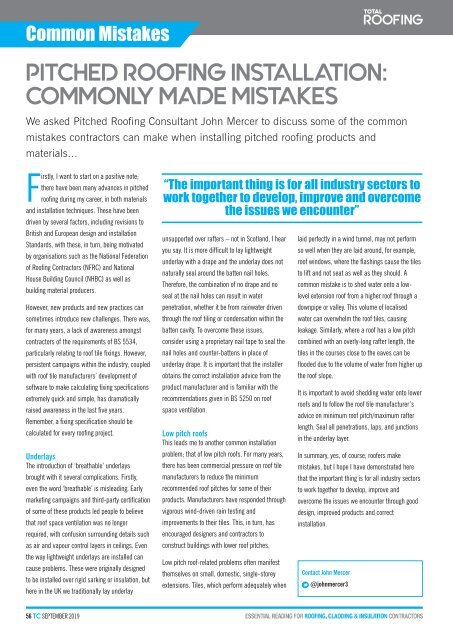September 2019
Create successful ePaper yourself
Turn your PDF publications into a flip-book with our unique Google optimized e-Paper software.
Common Mistakes<br />
PITCHED ROOFING INSTALLATION:<br />
COMMONLY MADE MISTAKES<br />
We asked Pitched Roofing Consultant John Mercer to discuss some of the common<br />
mistakes contractors can make when installing pitched roofing products and<br />
materials...<br />
Firstly, I want to start on a positive note;<br />
there have been many advances in pitched<br />
roofing during my career, in both materials<br />
and installation techniques. These have been<br />
driven by several factors, including revisions to<br />
British and European design and installation<br />
Standards, with these, in turn, being motivated<br />
by organisations such as the National Federation<br />
of Roofing Contractors (NFRC) and National<br />
House Building Council (NHBC) as well as<br />
building material producers.<br />
However, new products and new practices can<br />
sometimes introduce new challenges. There was,<br />
for many years, a lack of awareness amongst<br />
contractors of the requirements of BS 5534,<br />
particularly relating to roof tile fixings. However,<br />
persistent campaigns within the industry, coupled<br />
with roof tile manufacturers’ development of<br />
software to make calculating fixing specifications<br />
extremely quick and simple, has dramatically<br />
raised awareness in the last five years.<br />
Remember, a fixing specification should be<br />
calculated for every roofing project.<br />
Underlays<br />
The introduction of ‘breathable’ underlays<br />
brought with it several complications. Firstly,<br />
even the word ‘breathable’ is misleading. Early<br />
marketing campaigns and third-party certification<br />
of some of these products led people to believe<br />
that roof space ventilation was no longer<br />
required, with confusion surrounding details such<br />
as air and vapour control layers in ceilings. Even<br />
the way lightweight underlays are installed can<br />
cause problems. These were originally designed<br />
to be installed over rigid sarking or insulation, but<br />
here in the UK we traditionally lay underlay<br />
“The important thing is for all industry sectors to<br />
work together to develop, improve and overcome<br />
the issues we encounter”<br />
unsupported over rafters – not in Scotland, I hear<br />
you say. It is more difficult to lay lightweight<br />
underlay with a drape and the underlay does not<br />
naturally seal around the batten nail holes.<br />
Therefore, the combination of no drape and no<br />
seal at the nail holes can result in water<br />
penetration, whether it be from rainwater driven<br />
through the roof tiling or condensation within the<br />
batten cavity. To overcome these issues,<br />
consider using a proprietary nail tape to seal the<br />
nail holes and counter-battens in place of<br />
underlay drape. It is important that the installer<br />
obtains the correct installation advice from the<br />
product manufacturer and is familiar with the<br />
recommendations given in BS 5250 on roof<br />
space ventilation.<br />
Low pitch roofs<br />
This leads me to another common installation<br />
problem; that of low pitch roofs. For many years,<br />
there has been commercial pressure on roof tile<br />
manufacturers to reduce the minimum<br />
recommended roof pitches for some of their<br />
products. Manufacturers have responded through<br />
vigorous wind-driven rain testing and<br />
improvements to their tiles. This, in turn, has<br />
encouraged designers and contractors to<br />
construct buildings with lower roof pitches.<br />
Low pitch roof-related problems often manifest<br />
themselves on small, domestic, single-storey<br />
extensions. Tiles, which perform adequately when<br />
laid perfectly in a wind tunnel, may not perform<br />
so well when they are laid around, for example,<br />
roof windows, where the flashings cause the tiles<br />
to lift and not seat as well as they should. A<br />
common mistake is to shed water onto a lowlevel<br />
extension roof from a higher roof through a<br />
downpipe or valley. This volume of localised<br />
water can overwhelm the roof tiles, causing<br />
leakage. Similarly, where a roof has a low pitch<br />
combined with an overly-long rafter length, the<br />
tiles in the courses close to the eaves can be<br />
flooded due to the volume of water from higher up<br />
the roof slope.<br />
It is important to avoid shedding water onto lower<br />
roofs and to follow the roof tile manufacturer’s<br />
advice on minimum roof pitch/maximum rafter<br />
length. Seal all penetrations, laps, and junctions<br />
in the underlay layer.<br />
In summary, yes, of course, roofers make<br />
mistakes, but I hope I have demonstrated here<br />
that the important thing is for all industry sectors<br />
to work together to develop, improve and<br />
overcome the issues we encounter through good<br />
design, improved products and correct<br />
installation.<br />
Contact John Mercer<br />
@johnmercer3<br />
56 TC SEPTEMBER <strong>2019</strong>

















